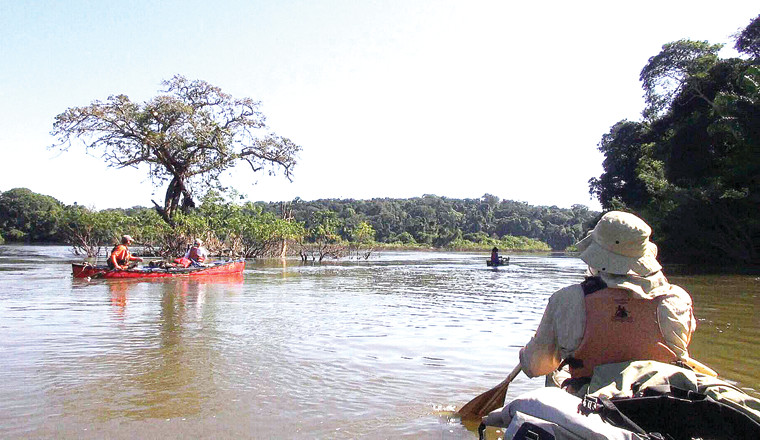Support the Timberjay by making a donation.
Ely paddlers on their own as they continue epic trip
RIO ROOSEVELT, BRAZIL—Ely adventurers Dave Freeman and Paul Schurke are heading into the most challenging stretch of their canoe journey down this remote Amazonian river— and they are doing it …
This item is available in full to subscribers.
Attention subscribers
To continue reading, you will need to either log in to your subscriber account, or purchase a new subscription.
If you are a current print subscriber, you can set up a free website account and connect your subscription to it by clicking here.
If you are a digital subscriber with an active, online-only subscription then you already have an account here. Just reset your password if you've not yet logged in to your account on this new site.
Otherwise, click here to view your options for subscribing.
Please log in to continue |
Ely paddlers on their own as they continue epic trip
RIO ROOSEVELT, BRAZIL—Ely adventurers Dave Freeman and Paul Schurke are heading into the most challenging stretch of their canoe journey down this remote Amazonian river— and they are doing it without the Brazilian members of their team.
“They are heading home after dropping us off at the headwaters,” said Dave Freeman during an interview with the Timberjay last Friday, conducted via satellite phone. Six Brazilian adventurers accompanied Freeman and Schurke on the first leg of their trip, but changes in travel plans prompted the Brazilians to head home before the most harrowing part of the trek.
While the team had originally planned to travel from the headwaters to a road crossing near the river’s mouth, political unrest in the area had forced the team to begin the trip well downstream of the headwaters, which allowed them to cover only the lower half of the river. The upper reaches of the river are controlled by an indigenous tribe, the Cinta Largo, who had initially permitted the team’s passage through their territory, but that permission was increasingly in doubt due to the political tensions in the region.
After completing their traverse of the river’s lower reaches, the team learned that the Cinta Largo had again confirmed permission to enter their lands, and that they had invited the team to end their journey at the Cinta Largo’s main village.
But by that time, the Brazilians had run out of time, so Freeman and Schurke will enter the world of the Cinta Largo, and the most remote and rapids-strewn portion of the river, by themselves.
“This is quite an honor that we have suddenly been granted,” said Schurke, who is hoping that he and Freeman will be able to spend a couple days at the village, getting to know a bit about the Cinta Largo culture. “It really puts a cap on the whole trip.”
As they were set to shove off last weekend, the two men were not sure how long it might take to reach the village, located about 120 river kilometers from their put-in location. “We have about 12 days to work our way down the river,” said Schurke, “but the rapids might take longer than we expect.”
While the rapids had proven incredibly difficult for Roosevelt’s team, which had to transport dugout canoes weighing over a ton through the jungle, they have been much easier for Freeman and Schurke, who are traveling with ultra-light canoes that fold up for easy transport. Even so, portaging often requires hacking a trail through the dense jungle, since the river has no established portage trails. Further, the two men expect to do most of the portaging at night, since the heat and humidity during the daytime make any physical activity difficult.
The two men described the headwaters put-in as extremely remote, and accessible only via a rough, three-hour long van trip from the nearest village. In its upper reaches, the river is surprisingly narrow. “It’s only about 65 feet wide here,” said Freeman. The dense jungle extends out over the river, providing welcome shade for the two travelers.
Since departing, Freeman and Schurke have seen and heard a vast array of wildlife, including macaws, monkeys, a capybara, and even a jaguar, a cat known to be both elusive and dangerous.
During the first half of their journey, along the wider, lower reaches of the Rio Roosevelt, Freeman and Schurke and their Brazilian team members ate mostly fresh fish, which they easily caught in the river. Freeman and Schurke expect they’ll be eating plenty of fish as they complete the remainder of their journey.
Locating landmarks
The Rio Roosevelt is named for former U.S. president Teddy Roosevelt, who led a group of explorers down what was then uncharted waters, known only as the River of Doubt. Roosevelt made that journey exactly 100 years ago, and Freeman and Schurke are re-creating this epic trek in recognition of the former president’s conservation ethic. They are also recognizing the 50th anniversary of the signing of the federal Wilderness Act.
As the two men travel, they’ve been watching and photographing landmarks first mentioned by Roosevelt in his expedition journal. “We enjoy comparing notes with the original expedition,” said Freeman. “So little has changed.”
Then, as now, the area is still controlled by rain forest natives, and only a handful of remote homesteads have been apparent along the way.
The men have found old grave markers and unusual rock formations also mentioned by Roosevelt. The two are also trying to recreate scenes photographed by Roosevelt’s expedition. “It’s an amazing experience,” said Schurke. “It’s powerful on every level.”






